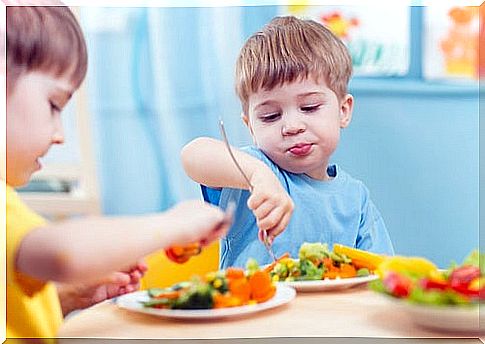Recommended Servings For 1 To 4 Year Olds

We can often feel insecure and worried about the amount and variety of food we are giving our young child. For your peace of mind, below we present a practical and functional guide with the types of food and servings recommended for children from 1 to 4 years old. Each child is different, so their diet may vary depending on their height, caloric expenditure (physical activity), etc…
In order to ensure that we are offering you a balanced diet with the proper proportions, let’s review some nutritional aspects that will allow us to make the necessary corrections.
How do we calculate the recommended servings of food for our children?
“There are several methods to calculate our children’s food portions, however, one that has gained great popularity in recent times is to calculate portions by measuring your hands.”

Our children’s organs are in proportion to their stature. The standard size of a child’s stomach from 1 to 4 years old corresponds to the fist of his hand, which is why his little hand is our perfect reference for calculating the proper servings of food.
The recommended servings guide then presented is organized according to the four fundamental food groups that should be present in our child’s main meals:
Recommended servings of food group 1: bread, pasta, cereals and tubers
You can put the equivalent of a fist of our child’s hand, which corresponds to a portion of cereal, tubers, quinoa, rice, wheat or pasta.
A slice of bread or 2 biscuits is equivalent to one serving. Select a food from this group to serve with each of your child’s meals.
Recommended servings of food group 2: fruits and vegetables
You can offer one or two servings of fruits and vegetables with each of your meals, ideally one serving of fruits and one serving of vegetables.
The portion of this food group should not be larger than your outstretched hands. You can also consider these references: an apple or a pear, half a cup of vegetables or a cup of vegetables is one serving.
Foods in this group provide a high nutrient content but are low in energy. If your child asks you for one more serving of this food group, don’t hesitate to provide it.
So that children don’t get tired of the same presentation, you can vary it and process vegetables and vegetables into soups and fruits into juices or jams.
The equivalent of two hands full is the reference serving for this food group.
Recommended servings of food group 3: milk, cheese and yogurt
You should put a serving of these foods 3 times a day, if you exceed the recommended daily doses it is quite likely that your child is not hungry for the next meal.
It is advisable that you give semi-skimmed milk or yogurt after your baby is two years old in a cup or cup. During the first year you can use a baby bottle with a formulation recommended by your pediatrician. In the case of cheese, take as a reference that a portion weighs 30 g.
Recommended servings of food group 4: meat, fish, eggs, nuts and pulses
Foods in this group are vital for your growth and should be present 2 or 3 times a day. Keep in mind that one egg, half a cup of cooked vegetables or 30 g of dried fruit is also equal to one serving.
Your child’s palm will indicate the perfect amount of protein for their age and height. This serving could be equivalent to 100 grams of meat, chicken or fish.

other types of food
Sweets such as cakes, cream and sweets should be provided on special occasions, in small quantities and in great moderation. The tip of the thumb of your hand is the measure for adding oil, mayonnaise and butter to your food.
If your child asks you for a little more food it is important that you give it to him, perhaps your energy expenditure is greater and your body is asking for it. After the age of 4 your child will be ready for you to increase your portion sizes.
For your child to be a healthy child you must provide a balanced diet with the recommended servings according to their age and type of activity.
Properly feeding your child is one of many ways to express how much you love them.









